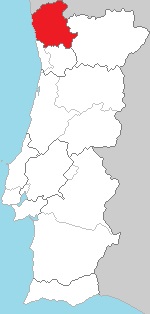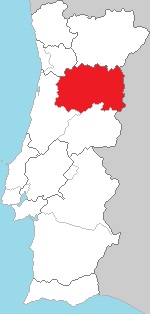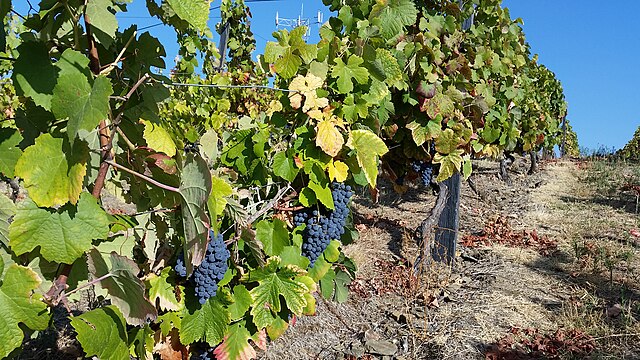The Minho Region (Vinho Verde)

Minho is the largest wine region in Portugal, producing nearly 100 million liters of Vinho Verde every year.
Vinho Verde wines often have a small sparkling sensation that enhances the taste and freshness.
Portugal is a great Rosé Wine nation. The cool climate in Minho gives good freshness to Rosé Wines.
Grapes | Wines |

|

|
Soil | Climate |

Granite |

Moderate Maritime |
The Douro Wine Region

The Douro region is the oldest wine region in the world (1756) and is classified as a World Heritage by UNESCO.
Famous for Port Wine, Douro also produces quality red wines (Douro Tinto) tasting from light Burgund to rich Bordeaux.
Black Grapes | White Grapes |

Touriga Nacional |

|
Port Wines | Red Wines |

|

|
Douro Climate

The Corgo Viaduct carries A4 over the Corgo river.
In general, Douro has a warm continental climate, but the climate is not uniform:
Baixo Corgo (below Corgo) in the west, has the mildest climate and produces the lightest wines.
Cima Corgo (over Corgo) is centered around the village of Pinhão, and has the majority of the famous Quintas (Estates).
Douro Superior in the east, is the hottest and driest regions. It goes all the way to the Spanish border. It has cold winters and hot summers and is a source of many wines of good quality.
Soil |
|
The soil in Douro is very rocky. Terraced vineyards (schist bedrocks) are common. Port vineyards are planted in silt layers on clay-schist spread over schist rocks. Table wines are planted on granite-based soils. |

The Dão Region

Dão is one of the best wine regions in Portugal.
The regionion is known to produces gastronomic wines, with very good acidity and delicate aromas.

Grapes | Wines |
|
|
|
Soil | Climate |
|
Granite |
Maritime |
The Bairrada Region

The Bairrada region is located in Beira Litoral, right in the centre of Portugal.
The region stretches along the coastline and has a typically Atlantic climate, with mild and rainy winters and summers softened by the winds coming from the sea.
Red wines from Bairrada are rich and dark colored.
The main grapes are Baga, Touriga Nacional, Merlot, Cabernet Sauvignon, and Syrah.
Black Grapes | White Grapes |

|

|
Soil | Climate |

Clay and limestone |

Maritime |
The Lisbon Region (Estramadura)

Lisbon is a region more famous for quantity than quality, but with some honorable exceptions.
The most famous red wines come from Alenquer, which is known for for full-bodied wines made from Touriga Nacional and Tinto Roriz (Tempranillo).
The most famous white wines come from Bucelas, which is known for fresh, minerally white wines made from Arinto.
Tinta Barocca grapes are rare, but can provide some quite rich and herbal red wines.
The region also grows international grapes like Cabernet Sauvignon, Merlot and Syrah.

Black Grapes | White Grapes |
|
Castelão |
|
Soil | Climate |
|
Calcareous Clay. |
Coast: |
The Alentejo Wine Region
The Alentejo region covers more than 30% of Portugal and it is the largest wine region in the country
There are eight subregions in Alentejo that are entitled to the Alentejo DOC designation. The name of the subregion may be on the label together with the name Alentejo DOC. The 8 subregions were formerly DOC regions, but in 2003 they were put together in the Alentejo DOC.

Georgia is known to be the home of ancient winemaking and amphora wines. But, Portugal is the only country that has dedicated appellations to amphora wines.
Black Grapes | White Grapes |

|

|
Soil | Climate |

Mountains. Hills. Valleys. |

Mediterranean |
The Madeira Island
Madeira is a Portuguese Island west of Africa.
In Portuguese, Madeira means "wood" for the sub-tropical forests that once covered the islands. In fact Madeira is an archipelago composed of 4 islands, 590 km off the coast of Morocco. Only 2 are inhabited: Madeira and Porto Santo.
The total surface is 741 km2 of which the vineyards occupy 490 hectares.
The climate is sub-tropical and temperate but the steep mountains (highest Pico Ruivo 1862mt) form different micro-climates.
Listed Wines:
Madeira is a fortified wine made on the Madeira Island.
Portuguese Wine Classifications
Vinho (de Mesa)
Vinho is the new classification for table wine.
Table wine was previously called "Vinho de Mesa" (Table Wine).
Vinho translates to Wine. Mesa translates to Table.
Vinho Regional
Before the IGP and DOP regulations were invented by EU, Portugal was originally divided into 14 "Regional Wine" areas and the wines were labeled "Vinho Regional".
Many wine producers still use the Vinho Regional denomination because the new rules are more stringent, or because they have chosen to use grape varieties or volumes that are not permitted in the IGP or DOP.
IGP
IGP (Indicação Geográfica Protegida) is the next quality level, previously called "Vinho Regional".
The IGP classification has more stringent rules for cultivation and production than vinho, and the wines must have a regional origin.
DOP / DOC
DOP (Denominação de Origem Protegida), previously called DOC (Denominação de Origem Controlada) is the highest Portuguese quality level.
DOP requires a limited geographical area and strict rules for both cultivation and production.
- Bucelas DOC
- Colares DOC
- Setúbal DOC
- Carcavelos DOC
- Alenquer DOC
- Torres Vedras DOC
- Arruda DOC
- Óbidos DOC
- Lourinhã DOC
- Ribatejo DOC
- Encostas d'Aire DOC
- Bairrada DOC
- Lafões IPR
- Vinho Verde DOC
- Trás-os-Montes DOC
- Porto DOC & Douro DOC
- Távora-Varosa DOC
- Dão DOC
- Beira Interior DOC
- Alentejo DOC
- Palmela DOC
- Lagos DOC
- Portimão DOC
- Lagoa DOC
- Tavira DOC
- Madeira DOC
- Graciosa IPR
- Biscoitos IPR
- Pico IPR



